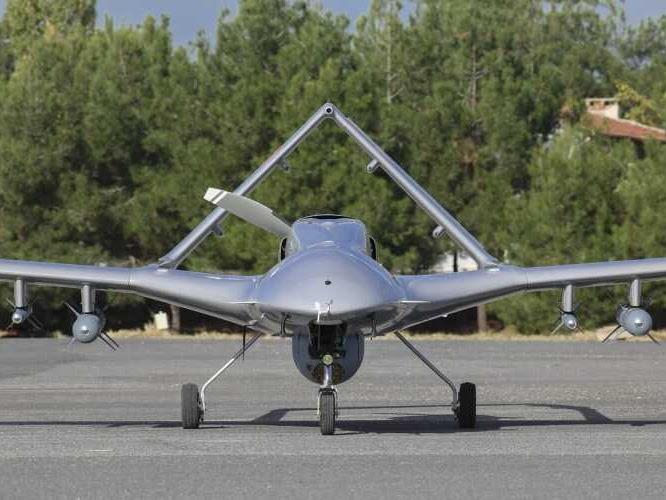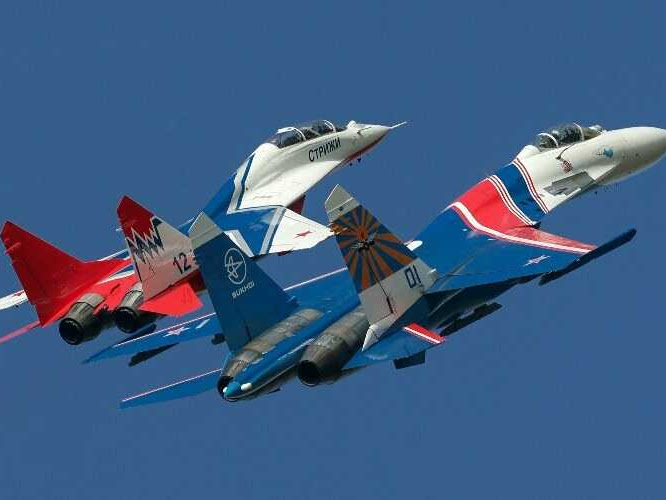Best Pics of the Month: June 2020
A U.S. Air Force B-52 Stratofortress from the 5th Bomb Wing, Minot Air Force Base, N.D., breaks away from a KC-135 Stratotanker from the 100th Air Refueling Wing, RAF Mildenhall, United Kingdom, after receiving fuel during a strategic bomber mission off the northern Norwegian coast, June 3, 2020. Joint and combined training, exercises and operations help mitigate and reduce security risks associated with increased human activity in the arctic. (U.S. Air Force photo by Tech. Sgt. Emerson Nuñez)
Alpha Company, 1st Battalion, 9th Cavalry Regiment, 2nd Armored Brigade Combat Team, 1st Cavalry Division's Sgt. Ian Ortiz ground guides a Bradley Fighting Vehicle onto the rail car during rail operations at Pazeimene Station in Pazeimene, Lithuania in preparation to redeploy back to Fort Hood, Texas. Pazeimene, Lithuania 06.01.2020. (U.S. Army National Guard photo by Sgt. Megan Zander)
Airmen assigned to the 911th Maintenance Group tow a C-17 Globemaster III into the new two-bay hangar at the Pittsburgh International Airport Air Reserve Station, Pa., June 4, 2020. The aircraft was the first to enter the new hangar, which will allow Airmen to safely perform maintenance on the C-17 in a controlled environment. (U.S. Air Force photo by Joshua J. Seybert)
Alaska Army National Guard Soldiers assigned to 1st Battalion, 207th Aviation Regiment executed an extraction mission via a CH-47 Chinook helicopter over Healy, Alaska., June 18, 2020. As part of a combined effort with the Department of Natural Resources, the Guardsmen rigged and airlifted "Bus 142," an historic icon from book and film, “Into the Wild,” out of its location on Stampede Road in light of public safety concerns. The bus will be stored at a secure site while the DNR considers all options and alternatives for its permanent disposition. AK, United States 06.18.2020. (Alaska National Guard Coutesy photo by Brent Goodrum, DNR)
Two combatant craft medium (CCM) operate in the Mediterranean Sea near the San Antonio-class amphibious transport dock ship USS New York (LPD 21), June 18, 2020. New York is conducting operations in U.S. 6th Fleet area of operations in support of regional allies and partners, and U.S. national security interests in Europe and Africa. Mediterranean Sea 06.18.2020. (U.S. Navy photo by Mass Communication Specialist 2nd Class Lyle Wilkie)
Twelve U.S. Air Force F-16CM Fighting Falcons, 12 Japan Air Self-Defense Force F-35A Lightning IIs, two U.S. Navy EA-18G Growlers, a U.S. Navy C-12 Huron, two U.S. Air Force MC-130J Commando IIs, and a U.S. Navy P-8 Poseidon participate in an elephant walk at Misawa Air Base, Japan, June 22, 2020. The display of aircraft showcased Misawa AB’s collective readiness and ability to generate combat airpower at a moment's notice to ensure regional stability throughout the Indo-Pacific. This was Misawa AB’s first time hosting a bilateral and joint elephant walk. (U.S. Air Force photo by Airman First Class China Shock)
An F-5N Tiger adversary fighter with the "Sun Downers" of Fighter Squadron Composite (VFC) 111 lands at Naval Air Station (NAS) Key West after training with the "Flying Eagles" of Strike Fighter Squadron (VFA) 122, June 23, 2020. Naval Air Station Key West is the state-of-the-art facility for combat fighter aircraft of all military services, provides world-class pierside support to U.S. and foreign naval vessels, and is the premier training center for surface and subsurface military operations. Key West, Fla. (June 23, 2020). (U.S. Navy photo by Danette Baso Silvers)
An F-16 Fighting Falcon with a "ghost" paint scheme departs Hill Air Force Base, Utah, for Nellis Air Force Base, Nev., June 3., 2020. The paint scheme is intended to replicate an adversary’s fighter jet. United States, allied, and partner-nation aircrews routinely train against accurate and realistic threats including aircraft painted to replicate those pilots might see in aerial combat. Hill Air Force Base, UT, United States 06.03.2020. (U.S. Air Force photo by R. Nial Bradshaw)
Sailors assigned to the Nimitz Carrier Strike Group perform preflight checks on aircraft aboard the aircraft carrier USS Nimitz (CVN 68). Nimitz, the flagship of Carrier Strike Group 11, is deployed conducting maritime security operations and theater security cooperation efforts. Pacific Ocean (June 12, 2020). (U.S. Navy photo by Mass Communication Specialist 2nd Class Greg Hall)
Airmen assigned to the 347th Rescue Group drop flares from an HH-60G Pave Hawk during a fini flight for Col. Bryan Creel, 347th RQG commander at Moody Air Force Base, Ga., June 5, 2020. The fini flight is a long-standing Air Force tradition that occurs when a pilot departs from an assigned unit. (U.S. Air Force photo by Senior Airman Hayden Legg)
The Los Angeles-class fast-attack submarine USS Asheville (SSN 758) transits alongside the U.S. 7th Fleet flagship USS Blue Ridge (LCC 19) during a submarine familiarization (SUBFAM) training. The SUBFAM was conducted so Blue Ridge's crew could observe the characteristics of a submarine and how it looks both acoustically and visually while in the vicinity of the ship. Blue Ridge is the oldest operational ship in the Navy, and, as U.S. 7th Fleet flagship, actively works to foster relationships with allies and partners in the Indo-Pacific region. Philippine Sea (June 14, 2020). (U.S. Navy photo by Mass Communication Specialist Seaman Brandon L. Harris)
Aircraft from Nimitz Carrier Strike Group fly in formation over the aircraft carrier USS Nimitz (CVN 68). Nimitz is underway conducting composite training unit exercise (COMPTUEX). COMPTUEX is an intensive exercise designed to fully integrate units of the carrier strike group, while testing a strike group's ability as a whole to carry out sustained combat operations from the sea. Pacific Ocean (June 2, 2020) (U.S. Navy photo by Mass Communication Specialist 3rd Class Keenan Daniels)
Alpha Company, 1st Battalion, 9th Cavalry Regiment, 2nd Armored Brigade Combat Team, 1st Cavalry Division's Sgt. Ian Ortiz ground guides a Bradley Fighting Vehicle onto the rail car during rail operations at Pazeimene Station in Pazeimene, Lithuania in preparation to redeploy back to Fort Hood, Texas. Pazeimene, Lithuania 06.01.2020. (U.S. Army National Guard photo by Sgt. Megan Zander)
Airmen assigned to the 911th Maintenance Group tow a C-17 Globemaster III into the new two-bay hangar at the Pittsburgh International Airport Air Reserve Station, Pa., June 4, 2020. The aircraft was the first to enter the new hangar, which will allow Airmen to safely perform maintenance on the C-17 in a controlled environment. (U.S. Air Force photo by Joshua J. Seybert)
Alaska Army National Guard Soldiers assigned to 1st Battalion, 207th Aviation Regiment executed an extraction mission via a CH-47 Chinook helicopter over Healy, Alaska., June 18, 2020. As part of a combined effort with the Department of Natural Resources, the Guardsmen rigged and airlifted "Bus 142," an historic icon from book and film, “Into the Wild,” out of its location on Stampede Road in light of public safety concerns. The bus will be stored at a secure site while the DNR considers all options and alternatives for its permanent disposition. AK, United States 06.18.2020. (Alaska National Guard Coutesy photo by Brent Goodrum, DNR)
Two combatant craft medium (CCM) operate in the Mediterranean Sea near the San Antonio-class amphibious transport dock ship USS New York (LPD 21), June 18, 2020. New York is conducting operations in U.S. 6th Fleet area of operations in support of regional allies and partners, and U.S. national security interests in Europe and Africa. Mediterranean Sea 06.18.2020. (U.S. Navy photo by Mass Communication Specialist 2nd Class Lyle Wilkie)
Twelve U.S. Air Force F-16CM Fighting Falcons, 12 Japan Air Self-Defense Force F-35A Lightning IIs, two U.S. Navy EA-18G Growlers, a U.S. Navy C-12 Huron, two U.S. Air Force MC-130J Commando IIs, and a U.S. Navy P-8 Poseidon participate in an elephant walk at Misawa Air Base, Japan, June 22, 2020. The display of aircraft showcased Misawa AB’s collective readiness and ability to generate combat airpower at a moment's notice to ensure regional stability throughout the Indo-Pacific. This was Misawa AB’s first time hosting a bilateral and joint elephant walk. (U.S. Air Force photo by Airman First Class China Shock)
An F-5N Tiger adversary fighter with the "Sun Downers" of Fighter Squadron Composite (VFC) 111 lands at Naval Air Station (NAS) Key West after training with the "Flying Eagles" of Strike Fighter Squadron (VFA) 122, June 23, 2020. Naval Air Station Key West is the state-of-the-art facility for combat fighter aircraft of all military services, provides world-class pierside support to U.S. and foreign naval vessels, and is the premier training center for surface and subsurface military operations. Key West, Fla. (June 23, 2020). (U.S. Navy photo by Danette Baso Silvers)
An F-16 Fighting Falcon with a "ghost" paint scheme departs Hill Air Force Base, Utah, for Nellis Air Force Base, Nev., June 3., 2020. The paint scheme is intended to replicate an adversary’s fighter jet. United States, allied, and partner-nation aircrews routinely train against accurate and realistic threats including aircraft painted to replicate those pilots might see in aerial combat. Hill Air Force Base, UT, United States 06.03.2020. (U.S. Air Force photo by R. Nial Bradshaw)
Sailors assigned to the Nimitz Carrier Strike Group perform preflight checks on aircraft aboard the aircraft carrier USS Nimitz (CVN 68). Nimitz, the flagship of Carrier Strike Group 11, is deployed conducting maritime security operations and theater security cooperation efforts. Pacific Ocean (June 12, 2020). (U.S. Navy photo by Mass Communication Specialist 2nd Class Greg Hall)
Airmen assigned to the 347th Rescue Group drop flares from an HH-60G Pave Hawk during a fini flight for Col. Bryan Creel, 347th RQG commander at Moody Air Force Base, Ga., June 5, 2020. The fini flight is a long-standing Air Force tradition that occurs when a pilot departs from an assigned unit. (U.S. Air Force photo by Senior Airman Hayden Legg)
The Los Angeles-class fast-attack submarine USS Asheville (SSN 758) transits alongside the U.S. 7th Fleet flagship USS Blue Ridge (LCC 19) during a submarine familiarization (SUBFAM) training. The SUBFAM was conducted so Blue Ridge's crew could observe the characteristics of a submarine and how it looks both acoustically and visually while in the vicinity of the ship. Blue Ridge is the oldest operational ship in the Navy, and, as U.S. 7th Fleet flagship, actively works to foster relationships with allies and partners in the Indo-Pacific region. Philippine Sea (June 14, 2020). (U.S. Navy photo by Mass Communication Specialist Seaman Brandon L. Harris)
Aircraft from Nimitz Carrier Strike Group fly in formation over the aircraft carrier USS Nimitz (CVN 68). Nimitz is underway conducting composite training unit exercise (COMPTUEX). COMPTUEX is an intensive exercise designed to fully integrate units of the carrier strike group, while testing a strike group's ability as a whole to carry out sustained combat operations from the sea. Pacific Ocean (June 2, 2020) (U.S. Navy photo by Mass Communication Specialist 3rd Class Keenan Daniels)






































































